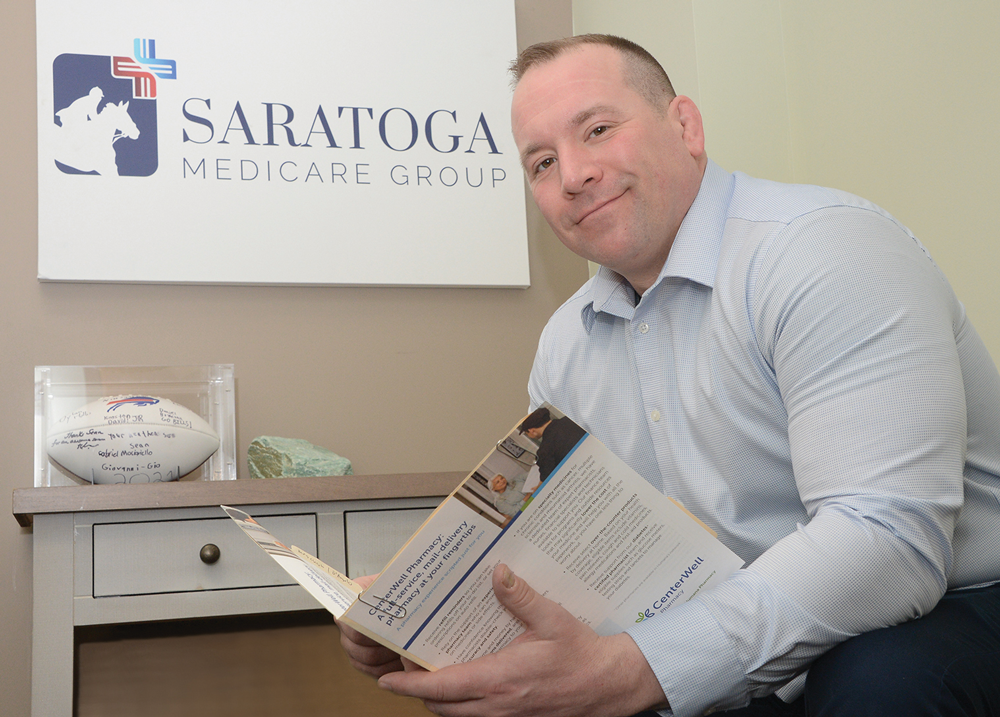
©2023 Saratoga Photographer.com
By Susan Elise Campbell
Sean Finnegan once researched stocks and bonds for his clients, but now he is finding the best Medicare Advantage plans for their specific needs as an independent Medicare broker.
Over the decade he was a financial advisor his clients often asked him questions about Medicare. He decided to look into how health insurance supplements worked.
“I literally thought: I can make a living helping people make this decision,” he said. For three years he worked as an independent Medicare Advantage broker on the side of his financial advisory role. Then he gave up his securities licenses and founded Saratoga Medicare Group, LLC at 125 High Rock Ave. in Saratoga.
Then COVID happened.
“It was hard for me at first to help clients over the phone because I’m a hands-on kind of guy,” Finnegan said. “That is how I build my client’s trust and how they know I am looking out for their best interests.”
Finnegan said the Center for Medicare Services made the role of an Independent Medicare Advantage Broker easier during the pandemic by improving on-line applications and making compliance more streamlined. Finnegan “was happy to sit down and show people what’s available and most cost effective for them” as safety mandates lifted.
As an independent, there is no advantage for Finnegan to enroll clients in one plan over another, he said. Medicare pays him the same fee regardless of the insurance company the client selects.
“I convey the information, but the client decides,” he said.
There’s an open enrollment period for Medicare recipients to join, switch or drop a plan. It runs from Oct. 15 to Dec. 7 each year and is effective the following calendar year.
Finnegan is busiest then, checking out the changes and costs associated with the various insurance carriers. But he said he is actively involved with new and existing clients all 12 months.
“This is not public knowledge, but there are ways to switch plans during the year,” he said. “My client may have enrolled in a pharmaceutical assistance plan, or there may have been an event, such as moving or a change in their health condition, which enables them to make changes outside that window.”
Finnegan starts enrollment season investigating all available plans in New York, which are dominated by three or four major carriers, he said. He uses software that compares the features and costs of the plans, which he then shows side-by-side to the client.
“When they are shown benefits on the monitor, sometimes they see one and say, ‘I want that,’” he said. “But the puzzle pieces are matching a plan that covers both the client’s prescriptions and their doctors. If the plan does not completely cover both, we may have to do some triage and think outside the box.”
For example, perhaps one plan includes their physician but not all their medications. One option might be to pick the plan and look for a discount prescription app, such as Good Rx, or search for coupons, he said.
“It always ends up working out,” said Finnegan. “The medication may even be available cheaper than it was under that plan.”
Finnegan said he stays proactive and in constant contact with clients. Oftentimes they’ll call him after receiving a communication.
“I tell them, just read me a part of the letter or send me a picture of it,” he said. “Usually I can tell them to just throw it away, but sometimes it is resolved in a few minutes. Whatever you do, don’t call their 800 number. About 90 percent don’t have to make a call and for the other 10 percent, we can contact the company together.
That level of service helps him determine, based on their conversations and client feedback, which companies are doing a good job responding and which are poor at customer service, he said.
“All companies have to put their best foot forward,” he said. “If they don’t, we won’t sign them up. This is a very competitive product. That means every year the features get a little better and the costs get a little lower.”
Open enrollment last year was seven weeks long. As plan changes were announced, Finnegan said he was able to look at all his client accounts to assess whether they were covered the best way, or if another plan would suit them better.
“I met with 120 clients in those seven weeks,” he said. “If you sit down together and explain the benefits, the worst thing is that you might find the client is in the right place. Insurance companies pay me to help people, so why not get the best health insurance option for them.”
Finnegan gets new clients through referrals, search engine optimization on the web, and workshops or individual meetings with clients of financial advisors. The aging population on Medicare is growing and his office is expanding quickly. After three years in the business, he has “a stack of resumés” on his desk to look over, he said.
“More people are turning 65 and need help, so I am willing to train agents once they are tested and licensed,” he said. His hiring requirements are “honest people who are willing to answer their phone.”
“I love this job and I work a lot, but it doesn’t seem like it sometimes,” he said. “If you go above and beyond for your clients, they will stick with you.”
Learn more at www.saratogamedicare.com.
